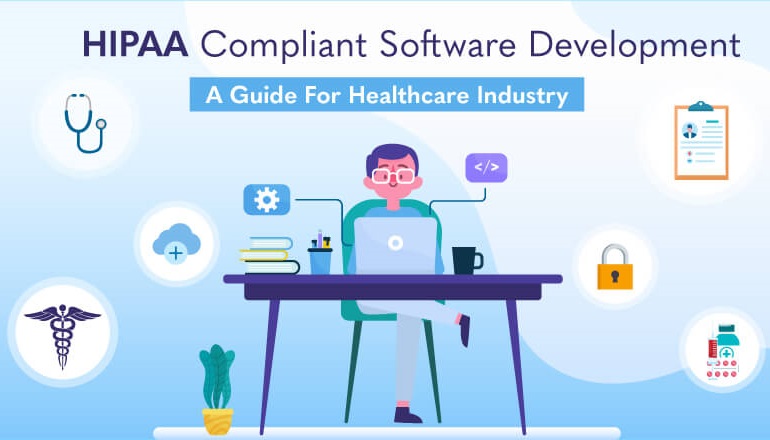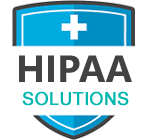
HIPAA Compliant Software Development
Healthcare software development has gained significant momentum over the last few years, and the market for mobile healthcare apps (mHealth) is estimated to grow by 43.9% by 2027. This is an inspiring statistic, but as the industry grows, the standards for managing sensitive patient data are becoming increasingly strict. HIPAA compliance is the password for all health-related apps that deal with sensitive patient data.
However, HIPAA compliance need not be intimidating. From my experience in building HIPAA-compliant apps, I can confidently state that it is almost no different from building an ordinary app, but it requires a little more precision, effort, and budget.
To build a HIPAA-compliant app, there are seven essential steps that you must follow. These steps will help ensure that your app complies with all the necessary regulations while maintaining the quality and usability of the app.
Let’s explore these seven essential steps together so that you can build a HIPAA-compliant app that meets all the necessary requirements and delivers an outstanding user experience.
What Is HIPAA And Why We Should Care?
The acronym HIPAA stands for “Health Insurance Portability and Accountability Act.” This important document lays out regulations for the exchange, transfer, and use of protected health information (PHI) while ensuring that this information is secured from unauthorized access, leakage, or interference.
HIPAA was introduced in 1996 as a solution to the growing problem of protecting patients’ data from fraudulent misuse while allowing its use for medical services by authorized staff only. The document established a set of rules for protecting electronic PHI, and in 2013, it was extended to cover data protection in the digital realm.
Understanding the history of HIPAA is important to appreciate the significance of this document in protecting patient privacy and confidentiality in healthcare. By complying with HIPAA regulations, healthcare providers and app developers can ensure that the sensitive patient data they handle is adequately protected and secured, while also allowing authorized staff to access and use it for medical purposes.
Legal Acts To Follow When Building HIPAA-Compliant Products
You are correct that HIPAA is not a single document, but rather a collection of legal acts that govern the use and protection of sensitive patient data. When building a HIPAA-compliant app, it is essential to follow all the relevant legal documents to ensure that your app complies with all the necessary regulations. Here are some of the key legal documents that you should be familiar with:
- HIPAA Privacy Rule – this rule sets the standards for the use and disclosure of protected health information.
- HIPAA Security Rule – this rule establishes standards for protecting electronic protected health information (ePHI) by requiring administrative, physical, and technical safeguards.
- HIPAA Breach Notification Rule – this rule requires covered entities to report any breach of unsecured PHI to affected individuals, the Department of Health and Human Services (HHS), and, in some cases, the media.
- HIPAA Enforcement Rule – this rule lays out the procedures for investigations and penalties for non-compliance with HIPAA regulations.
- HITECH Act – this act extends HIPAA’s privacy and security regulations to business associates, such as third-party service providers who handle sensitive patient data.
These are just a few of the key legal documents that you need to be aware of when building a HIPAA-compliant app. By following these legal guidelines, you can ensure that your app meets all the necessary regulatory standards while protecting sensitive patient data from unauthorized access or disclosure.
Do You Always Have To Follow HIPAA?
If you’re a healthcare co-founder planning to develop health-related apps, you may wonder if you need to comply with HIPAA rules. The short answer is no, but the honest answer is more complex: you most likely do.
HIPAA compliance rules apply when your app is used to:
- Collect personal data;
- Accumulate personal data;
- Store personal data;
- Transmit personal data;
- Operate personal data.
PHI refers to the confidential information that healthcare providers use. This data is sensitive in nature and requires protection to ensure the privacy and security of patients’ personal information. PHI, or protected health information, is subject to strict regulations and guidelines to safeguard its confidentiality, integrity, and availability. As a result, healthcare organizations must take appropriate measures to secure PHI to prevent unauthorized access, disclosure, or theft of this sensitive data. By maintaining the confidentiality and privacy of PHI, healthcare providers can build trust with their patients and ensure the safety and security of their personal information. This may include:
- patient and physician names
- telephone numbers
- geographic data
- social security numbers
- medical record numbers
- health plan beneficiary numbers
7 Ways To Make Your App HIPAA Compliant
As a lawyer, you might prefer to dive into the nitty-gritty details of the Health Insurance Portability and Accountability Act (HIPAA) Compliance Act. However, as a product-focused business, it’s important to understand HIPAA compliance from a product standpoint.
HIPAA regulations exist to protect the privacy and security of patients’ sensitive information. To ensure that your product is compliant, it’s important to view HIPAA regulations through the lens of your product. This can help you identify potential compliance issues and take proactive steps to mitigate risks.
Here are the top 7 instruments that you can use to ensure your product falls under all the HIPAA regulations:
Encrypted PHI
HIPAA compliance is a critical consideration for any business handling sensitive patient information. One of the most important aspects of HIPAA compliance is data encryption. But what does encryption mean in the context of HIPAA compliance?
In essence, encryption involves protecting patient data from unauthorized access or disclosure by hiding it from anyone other than the patient or authorized personnel. This means that all patient data, whether it’s stored, transmitted, or accumulated, must be encrypted to ensure it remains secure and confidential.
To achieve data encryption for your product, there are several steps you can take.
- One approach is to use cloud services with encrypted databases such as Amazon Relational Database Service (RDS) or Cloud SQL in the Google Cloud Platform.
- Another option is to transfer data via HTTPS and certificates, which provides secure communication between your app and its server.
- Using SSL certificates is also an effective way to encrypt data in transit.
By taking steps to encrypt patient data, you can ensure that your product meets HIPAA compliance standards and safeguards sensitive information from unauthorized access or disclosure. This can help build trust with your customers and ensure that your business avoids potential legal issues or penalties for noncompliance.
Active Logs-In Tracker
When it comes to HIPAA compliance, tracking login attempts and changes to protected health information (PHI) is critical. A HIPAA-compliant system should keep logs and event logs of all login attempts and monitor any changes made to PHI to ensure the data is not compromised.
In order to achieve HIPAA compliance, it’s important to not only track login attempts and changes, but also to maintain and review the logs regularly. This information should be transparent and accessible to all members of the system, regardless of whether the login attempts were successful or not.
Keeping a detailed log of all login attempts and changes can help your business identify potential security threats and prevent unauthorized access to PHI. This can help you maintain HIPAA compliance and ensure that your customers’ sensitive information remains protected at all times.
By implementing a system that tracks login attempts and changes to PHI, and making this information accessible to all system members, you can take proactive steps to achieve HIPAA compliance and ensure the security of sensitive patient information.
User Role Management
One of the most critical aspects of HIPAA compliance is ensuring that only authorized individuals have access to patient records. To achieve this, it’s important to manage user roles on your product and implement robust user authorization and monitoring functionality.
Your software should provide unique user identifiers to ensure that each user is properly authenticated and authorized to access patient records. By assigning specific roles and permissions to each user, you can ensure that only authorized personnel have access to sensitive patient information.
Backup Is NOT An Option
If you’re developing HIPAA-compliant software, implementing a backup and recovery system is essential to ensure the safety and security of sensitive patient data. A robust backup system is critical for preventing data loss, which can be devastating for both patients and healthcare providers.
When implementing a backup system, it’s important to ensure that the data is securely stored and encrypted to prevent unauthorized access. By encrypting backup data, you can ensure that even if the backup is accessed, the information remains confidential and secure.
A backup and recovery system can also help your business recover from potential data breaches or other security incidents. By having a system in place to recover data quickly and efficiently, you can minimize the impact of a security incident and protect patient privacy.
Automatic Log Out
Users often forget to log out of the app, which opens easy access to the PHI. Such a mistake can increase the risk of occasional interference with personal data or its illegal usage by somebody else if the device is used simultaneously. Once the user’s session is over, the system carries out an automatic logout from the system in order to secure the data contained in the user account.
Disposable Data
HIPAA compliance requires that sensitive patient data is only used for its intended purpose and is deleted when it is no longer needed. This is particularly important for electronically protected health information (ePHI), which can be easily stored and accessed for long periods of time.
Instant Emergency Mode
In the event of a data leak or interference, it’s critical for your HIPAA-compliant system to take immediate action to protect patient data and prevent further damage. The system should be designed to detect and respond to security incidents in real-time to minimize the impact of the breach and safeguard sensitive information.
Secure User Authentication
While it’s important to focus on protecting personal data within your app, it’s also crucial not to overlook the importance of a secure authentication process. The login process is the first line of defense against unauthorized access to sensitive patient data, and it’s essential to ensure that it is both secure and user-friendly.
For HIPAA-compliant apps, the standard username and password combination is no longer sufficient for secure authentication. So here are 2 basic new tech instruments that can simplify the sign-in process while providing security:
- Two-Factor Authentication (2FA). The most direct way to secure your password information is by applying the 2FA;
- Biometrics Authentication – the thing that will make the life of users much more accessible. The uniqueness of the human print and face of voice helps to provide a higher level of security while simplifying the process of sign-in.
The most important principle in developing a HIPAA-compliant app is to ensure that users’ personal data is protected to the highest degree. The consequences of HIPAA breaches can be costly, both in terms of financial penalties and damage to your reputation. However, building a HIPAA-compliant app is no more difficult than building any other type of app. It simply requires greater attention to detail when it comes to security.
In conclusion, developing a HIPAA-compliant app is not an insurmountable task. It simply requires a commitment to security and attention to detail. By following the guidelines and best practices for HIPAA compliance, you can protect user data and ensure the success of your app.




